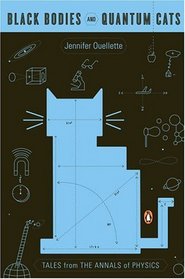Helpful Score: 1
the history of physics made accessible to the mathematically stunted, like me. oullette uses popular culture to couch the important advancements in physics, from the discovery of gravity to the development of the microscope and the discovery of the atom, to roller coasters and velcro, the telephone, the radio, x-ray, and finally through string theory. accessible, user-friendly, and fun. even if it is physics.
What a delightfully palatable book! Ouellette makes difficult physics concepts easier to understand by using cultural references as analogies. From literature to movies, this series of essays speaks of X-rays, string theory, and time travel.
I don't rate it five stars because the chapter on the quarks and bosons shouldn't have been included. The concept is amazingly difficult, itself, but I thought it wasn't adequately explained, not like the other subjects, anyway. I guess you can't really ignore something as important as the discovery of a quark, but I was hoping for a clearer definition, like Ouellette gave in all previous and subsequent chapters.
I was floored that she could actually explain the necessity of having 11 dimensions in order for String Theory to hold. I had never understood the importance of the other seven. The chapters on neutrinos and the expanding universe unnerved me in a big way. You start thinking about the world in an entirely different way once you realize how simultaneously large and small it is.
I don't rate it five stars because the chapter on the quarks and bosons shouldn't have been included. The concept is amazingly difficult, itself, but I thought it wasn't adequately explained, not like the other subjects, anyway. I guess you can't really ignore something as important as the discovery of a quark, but I was hoping for a clearer definition, like Ouellette gave in all previous and subsequent chapters.
I was floored that she could actually explain the necessity of having 11 dimensions in order for String Theory to hold. I had never understood the importance of the other seven. The chapters on neutrinos and the expanding universe unnerved me in a big way. You start thinking about the world in an entirely different way once you realize how simultaneously large and small it is.




![header=[] body=[Get a free book credit right now by joining the club and listing 5 books you have and are willing to share with other members!] Help icon](/images/question.gif?v=90afaeb39)
